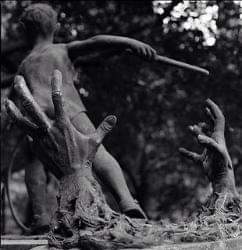The story behind the ‘Simpson and his Donkey’ statue
This evocative statue is located in the gardens of Melbourne’s Shrine of Remembrance.
The tale of Simpson and his donkey rescuing wounded soldiers from the murderous heights of Gallipoli has taken on mythical proportions in Australia.
It’s become a sacred pillar of the Anzac legend.
And unsurprisingly its sculpture, designed by Wallace Anderson in 1933, is laden with biblical meaning.
A donkey, after all, carried Mary across the Holy Land. Simpson was a real life exemplar of the Good Samaritan parable. And like Jesus Christ, Simpson sacrificed himself so others could live.
Now, the real story behind Simpson and the statue turns out to be much more interesting than the one-dimensional legend.
Firstly, the knock-about Simpson’s real surname was Kirkpatrick; secondly, he was English, not Australian. And finally, rather than working with the medical corps, Kirkpatrick had adopted his own ‘roving commission’.
As for the sculpture, back in 1933 veteran groups vehemently opposed its commissioning because it honoured one individual above all others.
Renowned artist Arthur Streeton worried that a statue of an ass would not be in keeping with the shrine’s spirit of neoclassicism. Consequently, it would not be life-sized, but a half size miniature.
And finally, the aesthetically beautiful statue of ‘Simpson’ looked nothing remotely like the slight man himself, who wore a Tommy-style cap, no tunic, and trousers held up by braces. The statue took on the mythical character of a ‘lithe and bronzed’ Anzac in ‘perfect manhood’.
Anderson, a veteran himself, must have felt that people demanded a hero. And everyone knew what a stylised hero must look like.
As for the statue, it turned out to be irresistible to children, whose repeated attempts to ride Murphy often seriously damaged the statue’s reins.
Photograph credit: A Place to Remember: A History of the Shrine of Remembrance










Comments
Post a Comment